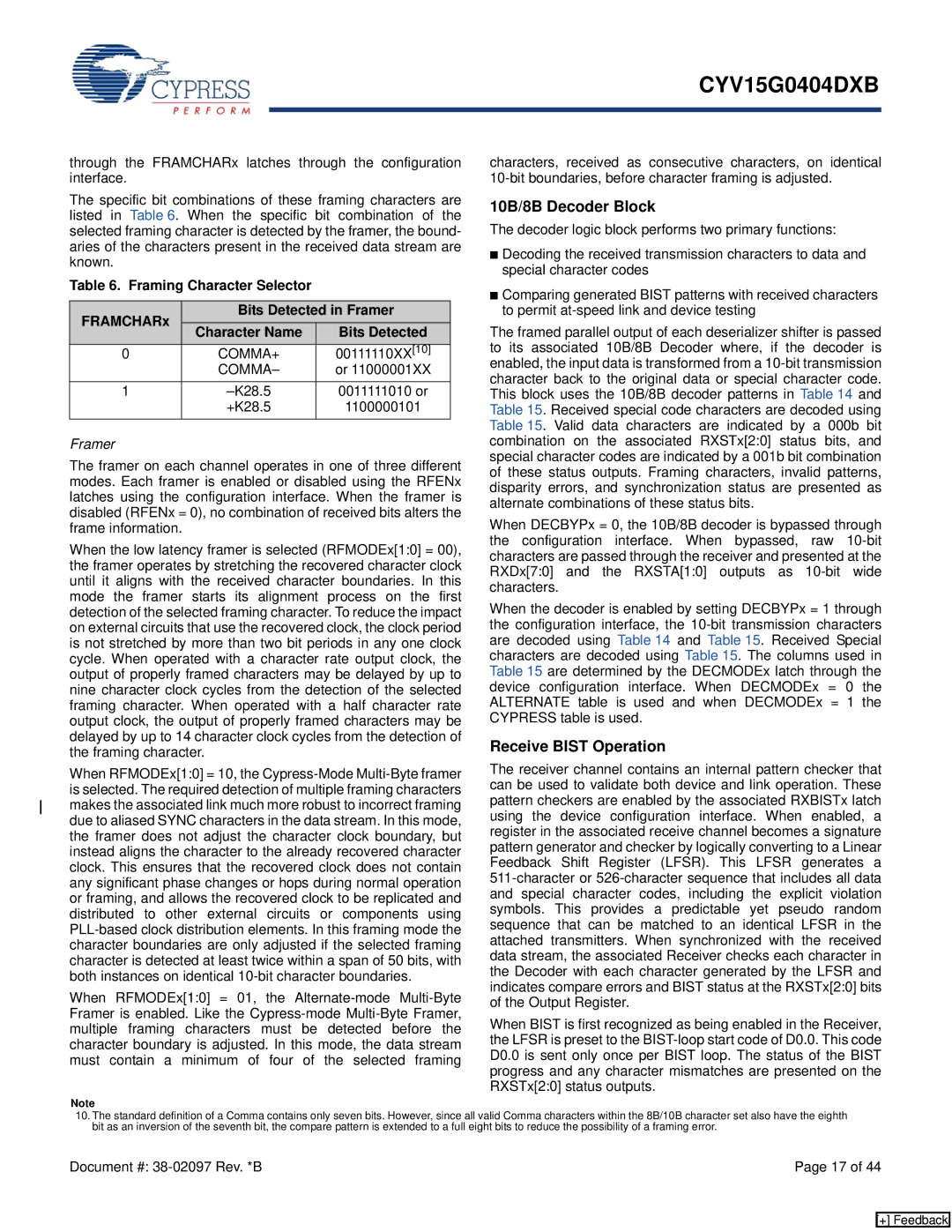
CYV15G0404DXB
through the FRAMCHARx latches through the configuration interface.
The specific bit combinations of these framing characters are listed in Table 6. When the specific bit combination of the selected framing character is detected by the framer, the bound- aries of the characters present in the received data stream are known.
Table 6. Framing Character Selector
FRAMCHARx | Bits Detected in Framer | ||
Character Name | Bits Detected | ||
| |||
0 | COMMA+ | 00111110XX[10] | |
| COMMA– | or 11000001XX | |
1 | 0011111010 or | ||
| +K28.5 | 1100000101 | |
Framer
The framer on each channel operates in one of three different modes. Each framer is enabled or disabled using the RFENx latches using the configuration interface. When the framer is disabled (RFENx = 0), no combination of received bits alters the frame information.
When the low latency framer is selected (RFMODEx[1:0] = 00), the framer operates by stretching the recovered character clock until it aligns with the received character boundaries. In this mode the framer starts its alignment process on the first detection of the selected framing character. To reduce the impact on external circuits that use the recovered clock, the clock period is not stretched by more than two bit periods in any one clock cycle. When operated with a character rate output clock, the output of properly framed characters may be delayed by up to nine character clock cycles from the detection of the selected framing character. When operated with a half character rate output clock, the output of properly framed characters may be delayed by up to 14 character clock cycles from the detection of the framing character.
When RFMODEx[1:0] = 10, the
When RFMODEx[1:0] = 01, the
Note
characters, received as consecutive characters, on identical
10B/8B Decoder Block
The decoder logic block performs two primary functions:
■Decoding the received transmission characters to data and special character codes
■Comparing generated BIST patterns with received characters to permit
The framed parallel output of each deserializer shifter is passed to its associated 10B/8B Decoder where, if the decoder is enabled, the input data is transformed from a
When DECBYPx = 0, the 10B/8B decoder is bypassed through the configuration interface. When bypassed, raw
When the decoder is enabled by setting DECBYPx = 1 through the configuration interface, the
Receive BIST Operation
The receiver channel contains an internal pattern checker that can be used to validate both device and link operation. These pattern checkers are enabled by the associated RXBISTx latch using the device configuration interface. When enabled, a register in the associated receive channel becomes a signature pattern generator and checker by logically converting to a Linear Feedback Shift Register (LFSR). This LFSR generates a
When BIST is first recognized as being enabled in the Receiver, the LFSR is preset to the
10.The standard definition of a Comma contains only seven bits. However, since all valid Comma characters within the 8B/10B character set also have the eighth bit as an inversion of the seventh bit, the compare pattern is extended to a full eight bits to reduce the possibility of a framing error.
Document #: | Page 17 of 44 |
[+] Feedback
